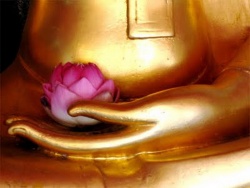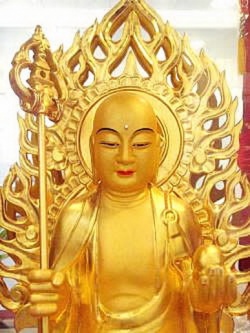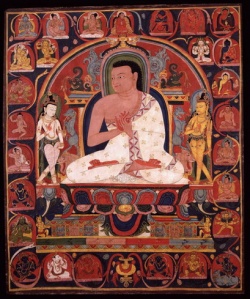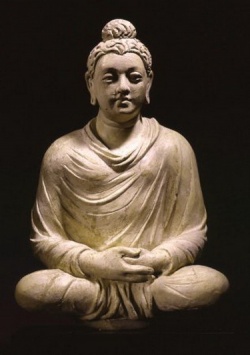How things exists, Two Truths – Vaibhashika school
Subject: Vaibhashika (Particularist)
Introduction:
This is Theravada school.
Based on Abhidharma teaching. The famous text based on Vasubandhu’s Treasury of Higher Knowledge (Abhidharmakosha) and his autocommentary (Abhidharmakoshabhashyam).
How things exists (as explained in Vaibhashika) ?
They are existed in :
1. Compounded phenomena
2. Uncompounded phenomena
The definition of Uncompounded phenomena
something that is not created by the coming together of causes and conditions,
something that does not change moment by moment during its existence, and therefore,
something that cannot perform a function.
So what are the Uncompounded phenomena, example?
1. Space
2. Two type of cessation.
What are two type of cessation?
1. Non-analytical cessation, refers to the temporary ceasing of certain types of negativities, misconceptions, and so on when we enter the meditative concentration that interrupts our attachment to sensory objects.
When the concentration stops, our attachment naturally returns.
2. Analytical cessation occurs by means of the meditation analyzing the reality of things and events, and is a complete cessation in that there is no reversal. It is the full cessation borne of realisation.
What about Space?
Space is the mere absence of obstructions; as such it is not the result of any causes and conditions.
What is Compounded phenomena?
Compounded phenomena is a synonym for impermanent phenomena and refers to those things that come into being because of cause and conditions.
How is Compounded phenomena categorised?
1. Form
2. Consciousness
3. Nonassociated compositional factors.
1. Form refers to all gross material things – Shapes, colour, pen, book, and so forth – IT ALSO INCLUDE the any object of the sensory consciousness.
2. Consciousness refers to all mental events.
There are six main consciousness.
The first five are related to the sense organ:
sight (eye),
hearing (ear),
smell (nose),
taste (tongue), and
touch (body).
The sixth is the mental consciousness, in which we can include all sorts of mental consciousness, in which we can include all sorts of mental processes:
thoughts, emotions,
intelligence,
feelings,
and so on, as well as all uncontaminated consciousness.
3. Nonassociated compositional factors, refers to all other phenomena that come together due to causes and conditions but don’t fit into the other two categories.
Classic example is DREAM. We may dream of a nice beach.
Although the dream itself is consciousness, the image that appears in the dream is not consciousness, nor is it form. It is a compounded phenomenon, since it has come into existence due to cause and conditions.
Nonassociated compositional factors also includes abstract phenomena, such as time, continuity, aging, birth, and the very important phenomenon of person.
Person – our sense of identity, our “I” – is neither form nor consciousness, and yet it is compounded phenomenon because it come into existence due to the aggregation of cause and conditions.
All Buddhist schools assert that this is correct.
What is the view of Vaibhashika on TWO TRUTH?
If the awareness of something does not operate after the thing is destroyed or mentally separated into other things,
Then that thing exists conventionally, like a pot or water. Other exist ultimately.
This is the simplest explanation of conventional truth, it just need some degree of flexibility in our thinking, not difficult at all actually.
It says that when an object is destroyed or mentally separated into parts, the mind can no longer hold on to object; therefore, it is a conventional truth.
For example, if a glass jar is dropped on the floor, it will shatter and no longer be a glass jar.
At that moment, the mind that apprehended the glass jar can no longer apprehend it, because it no longer exists.
So glass jar is a conventional truth and so are many material objects in this world.
Vasubhadhu also uses the example of water, which is called a “collection”.
Water has no shape of its own but fits into whatever contains it, such as a glass or a riverbank.
When water is confined by river banks, we see it as a river, but if the things that give the water shape(the banks) is gone, as in the time of a flood, we can no longer perceive the water as a river, and so “river” is a conventional truth.
How about Mental Events? Which can not be destroyed.
Although object cannot be destroyed, it can be separated into parts.
The mind perceiving an hour can break that hour down into minutes and the minutes into seconds; time can be “mentally separated.”
Therefore, the mind no longer apprehends its original object.
Objects that have this quality are called conventional truths.
In each of the above examples the whole object is imputed onto its parts – that is, the complete thing is imposed onto what is nothing more than a collection of substantial parts. When those parts are separated, the object can no longer hold as an entity.
Therefore, according to Vaibhashika, these are examples of imputedly existent objects. Imputed existence and conventional truth are synonyms.
If the object is not a collection of substantial parts but is the actual substance that makes up those parts, then it is a substantially existent object.
Substantial existence and ultimate truth are synonyms.
Sometimes the term collective convention is used.
A house is a collective convention because it comes into existence dependent on all the bits – the bricks, windows, and so on; the mind apprehends the whole house in dependence on all those things.
Sometimes the term conventional dependence on others is used.
For the mind to apprehend “year” it must depend on the continuity of each of the twelve months, so the mind is unable to apprehend “year” without it being a collection of the twelve months of which it is comprised. This is conventional dependence on others.
The term conventional truth dependent on other substances is also used.
The molecules that make up water are not the whole glass of water that we apprehend.
When the water molecules come together as a glass of water, this is a conventional truth dependent on other substances.
So, What is the Ultimate Truth and Substantial Existence?
Other than those are the ultimate truths, because even if the mind is separated from the object, such as when (the object) is destroyed, the mind apprehending it still operates, for example, the mind apprehending form.
Other here refers to anything that cannot be destroyed or mentally separated into other things.
This is ultimate truth according to Vaibhashika school.
What can’t be broken down? There are three main categories:
1. the aggregates
2. uncompounded phenomena
3. substantial particles (of matter or mind)
For Vaibhashika school, although the actual aggregation – the collection of parts that make up an object – can be separated further and further, the aggregate itself – form, feeling, consciousness, and so on – cannot.
The Vaibhashikas differentiate between the aspect of having form and the form itself. (very important point to remember)
A body is made of a collection of parts, which are further make up of collections of particles.
Both body, parts, and particles are all form.
If you break the congregation of particles up into smaller groups, the large congregation is destroyed, but it is still form.
As the object is progressively broken up, the mind apprehending the various level of congregation is cancelled, but the mind apprehending form is never destroyed.
Take the example of glass jar.
A glass jar has a nature as a jar; it also has a nature of being form.
As a glass jar is a conventional truth, but as a form it is an ultimate truth, because even if the jar is shattered by a hammer and the mind that apprehends the jar can no longer operated, thousands of small pieces exists that are still form, and that form is something that the mind can still apprehend.
The mind that apprehended the glass jar is cancelled, but the mind that apprehends form still operates because form can never be cancelled.
Form exists substantially because in order to exist it does not depend on other substances.
And form exists ultimately because no matter how much you cut it into pieces, it will still stay as form.
Feeling, whether we consider a feeling of great pain or just a subtle pain, whether it lasts for a long time or short duration, all of these instances are still feeling and cannot be broken down.
The feeling of happiness is a conventional truth because as a specific mental event it must have a duration, and that duration, whether long or short, can be divided into shorter periods. No matter how long that happiness lasts, however, it is still feeling and that is ultimate truth.
You would have realised by now that, when feeling that describe certain mental events, it become conventional truth because it can be broken down because of the duration.
However, not rejecting the existence of feeling, the feeling is do exist and is term ultimate truth.
This is to avoid the two extreme of nihilism and eternalism.
For Vaibhashika school’s point of view, both conventional truth and ultimate truth coexist within one object.
The body is a conventional truth and the body as form as ultimate truth.
For this school, uncompounded phenomena, such as the cessation of suffering or space (the mere absence of obstruction) are substantially exist.
They are ultimate truths because their existence does not depend on other things and they do not change while they exist.
Substantial objects are also ultimate truths. Here, substantial does not mean “made of substances” but the actual substance itself.
For this school, it means the fundamental building block of the universe, called the partless particle. In the case of mental events, the partless moment of consciousness.
Vaibhashikas refute the non-Buddhists’ concept of self as permanent, unitary, and indivisible (the soul concept as permanent), Vaibhashikas assert that the self can not exist as a different entity from the mind/body aggregates.
The body is imputed on substantially existing particles that make it up, the sense of “I” is imputed onto the mind/body aggregation.
The Vaibhashika understanding of the nature of self goes only as far as the selflessness of person; this is the extent of their emptiness.
They do not talk about other type of emptiness that we find in the higher schools.
At this level, the term emptiness refers only to the person being empty of permanent, unitary, and indivisible reality.
For Vaibhashika, ultimate truths are not necessarily emptiness.
For Vaibhashika, there are other ultimate truths with the compounded phenomena – form, feeling, and so on, or the fundamental building blocks of matters, or the shortest moment of consciousness. They assert all these as ultimate truths, but they are not emptiness.
Flaw of Vaibhashika theory ( according to other higher schools.)
1. The debate between the Vaibhashikas and the other schools is not about whether a partless particle can be further divided but whether the fundamental constituents of the particle, such as the earth and water elements, can stand by themselves without relying on the other elements.
Vaibhashika scholars say that the partless particle is the smallest unit of matter or mind and, hence, is indivisible.
Scholars of the other schools contend that the elements (earth, fir, and so on) that constitute a partless particle are themselves constituents of that particle, and that in it itself makes the particle divisible.
In this way, the whole concept of partless particles is called into question.
If you ask the Vaibhasikas, these smallest units of matter have no parts (partless), which implies no sides or directions and so on, then it stands to reason that two particles would take up no more room than just one.
Either these particles have sides and are “atoms” as we would know them, or they are partless and without sides. In this case, there could be no spatial relationship wherein the left side of one particle would touch the right side of another.
That being so, two particles would take up the same space as one, as would three, one hundred, one million, and so on.
An object, which supposedly consists of millions of these partless particles, would itself take up no more space than one particle. Therefore, the other schools argue, it is impossible for matter to be built from such fundamental partless particles.







